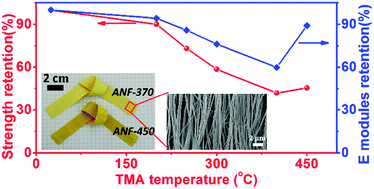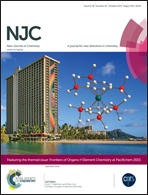Thermal, mechanical and thermomechanical properties of tough electrospun poly(imide-co-benzoxazole) nanofiber belts
Abstract
Mechanically strong electrospun nanofibers at high temperature are highly desired in the aerospace industry, high temperature filtration and fire protection clothing. In the present work, highly tough poly(imide-co-benzoxazole) (PI-co-PBO) nanofiber belts with excellent thermal stability, mechanical properties and thermomechanical properties were produced from the highly viscous methoxy-containing polyamic acid (MeO-PAA) solution by electrospinning followed by thermal rearrangement. The chemical structures of the polymer nanofibers and the corresponding thermal rearrangement were confirmed by 1H-NMR, FT-IR and TGA. The mechanical properties and thermomechanical properties were characterized by a tensile test and thermomechanical analysis (TMA). The aligned nanofiber belts heat-treated at 450 °C (ANF-450) had the highest tensile strength of 559 MPa, a modulus of 11.2 GPa and a toughness of 12.0 J g−1, respectively, which were much higher than those of the pure PBO films made by thermal rearrangement. The TMA test showed that the ANF-450 exhibited a high tensile strength retention of 90% and a modulus retention of 94% at a high temperature of 200 °C. These excellent thermomechanical properties make electrospun PI-co-PBO nanofibers promising candidates in high temperature areas.



 Please wait while we load your content...
Please wait while we load your content...